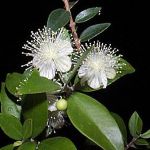| Common Name: |
Myrtle |
| Botanical Name: |
Myrtus communis |
| Genus: |
Myrtus |
| Family: |
Myrtaceae |
| Native Location: |
Mediterranean, SW Europe |
| Cultivation: |
Well-drained, neutral to alkaline soil in sun. Given sharply drained soil and protection from cold, M. communis may survive down to -10°C (14°F) outdoors. Even with optimum conditions, 'Variegata' rarely survives below -5°C (23°F). Trim plants in spring and remove damages or dead shoots. Plants grown under cover may be damaged by whitefly and spider mites. |
| Propagation: |
By seed sown in autumn (species only); by semi-ripe cuttings in late summer. |
| Harvest: |
Plants are cut with or without flowers and distilled for oil. Leaves are picked as required and used fresh, or dried for use in infusions. Flower buds are picked before opening and dried. Fruits are collected when ripe and dried for using whole or ground. |
| Height: |
3m (10ft) |
| Width: |
3m (10ft) |
| Variations: |
Flore Pleno
Has longer lasting, fully double white flowers |
Subsp. tarentina
Syn.Jenny Reitenbach, Microphylla, Nana
(Tarentum myrte)
Is a compact, free-flowering varient with narrowly elliptic leaves to 2cm (¾in) long, smaller, pink-tinged flowers, and white fruits
Height: 1.5m (5ft)
Width: 1.5m (5ft) |
Subsp. tarentina
Microphylla Variegata
Has white-margined leaves. |
Variegata
Has leaves variegated gray-green and creamy-white |
|
| Hardiness: |
Z9-10 |
| Parts Used: |
Whole plant, leaves, flower buds, fruits, oil. |
| Properties: |
An aromatic, astringent herb that is antiseptic, and an effective decongestant. |
| Medicinal Uses: |
Internally for urinary infections (as a substitute for Agathosma crenulata (See, Oval-Leaf Buchu), vaginal discharge, bronchial congestion, sinusitis, and dry coughs. Externally for acne (oil), gum infections, and hemorrhoids. |
| Culinary Uses: |
Leaves, flower buds, and fruits are used to flavor dishes or pork, lamb, and small birds, sauces,a nd liqueurs, such as myrthe, especially in Corsica and Sardinia. Fruits (known as mursins) are used as a spice in the Middle East. |
| Economic Uses: |
Oil is used in soaps, skin care products, and perfumery; also as food flavoring. |
| Bibliography: |
The Encyclopedia of Herbs by Deni Bown Copyright © 1995,2001 Dorling Kindersley Limited pg. 286 |
